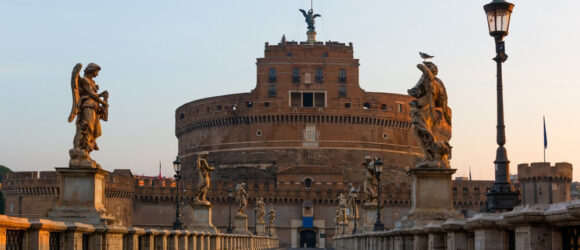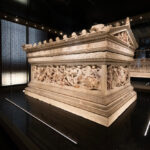Rome’s Architectural Marvel: The Transformation of Hadrian’s Mausoleum Through History

Rome, a city renowned for its architectural grandeur, houses many iconic structures that stand as testaments to its rich history. Among these, Hadrian’s Mausoleum, the Castel Sant’Angelo, holds a unique place. Initially built as the final resting place for Emperor Hadrian, this monumental structure has undergone a remarkable transformation over the centuries, serving as a fortress, papal residence, and even a prison. This blog explores the evolution of Hadrian’s Mausoleum, highlighting its architectural ingenuity and historical significance, as well as its notable angel statue sitting atop the structure.
What You Need to Know About Hadrian’s Mausoleum’s Angel Statue and Other Features
- Hadrian’s Mausoleum Was Built as a Grand Imperial Tomb – Originally constructed in 139 AD as Emperor Hadrian’s final resting place, the mausoleum housed the remains of several Roman emperors before being repurposed.
- It Transformed into a Fortress and Papal Refuge – During the medieval period, the structure was fortified and became the Castel Sant’Angelo, serving as a military stronghold and a refuge for popes, including during the 1527 Sack of Rome.
- The Angel Statue Symbolizes Protection and Renewal – The bronze statue of Archangel Michael, placed atop the fortress in 1753, commemorates a legendary vision in which the archangel signaled the end of a deadly plague in Rome.
- It Remains One of Rome’s Most Iconic Landmarks—Today, Castel Sant’Angelo is a historical museum that offers visitors insights into its past, stunning frescoed rooms, and breathtaking panoramic views of Rome.
The Construction of Hadrian’s Mausoleum: A Monument to Imperial Power
Here’s what you need to know about the monumental tomb with an angel atop its highest peak.
Hadrian’s vision and design (135–139 AD)
Commissioned by Emperor Hadrian around 135 AD, the mausoleum was designed to be an awe-inspiring tomb for him and his successors. Modeled after the Mausoleum of Augustus, it was constructed on the banks of the Tiber River, separate from Rome’s traditional burial grounds.
The architectural plan included:
- A massive cylindrical drum adorned with white marble and elaborate statues.
- A square base made of tufa and travertine, creating a strong foundation.
- A bronze quadriga (a four-horse chariot) at the top, likely carrying a statue of Hadrian.
- A grand bridge, the Ponte Elio, connecting the mausoleum to the city.
Hadrian’s Mausoleum (now the Castel Sant’Angelo) was the tallest building in Rome during the Roman Imperial era, specifically from its completion in 139 AD until the construction of St. Peter’s Basilica in the 16th century.
A royal resting place for Roman Emperors
Following Hadrian’s death in 138 AD, his remains were placed inside the mausoleum alongside those of his wife, Sabina. The structure also became the tomb of later emperors, including Antoninus Pius, Marcus Aurelius, and Caracalla, before it ceased functioning as a mausoleum.
From Mausoleum to Military Stronghold: The Rise of the Castel Sant’Angelo
This treasure of Italy switched purposes to become a military stronghold and place of escape for the leaders of the Catholic Church. Here’s the history of the structure during this era.
Transformation into a fortress (5th–6th Century AD)
As the Roman Empire declined, the once-sacred mausoleum was repurposed into a defensive fortress. Gothic invasions in the 5th century led to the fortification of the structure. By the 6th century, it had become a key military post under Byzantine rule.
The modifications included:
- Reinforcement of the walls to withstand sieges.
- The addition of battlements and military towers.
- Strategic positioning for defense along the Tiber River.
Papal refuge and secret passageways (10th–16th Century)
By the 10th century, the Castel Sant’Angelo became the property of the Catholic Church, serving as a refuge for popes in times of crisis. One of its most famous features, the Passetto di Borgo, was a secret corridor that connected the Vatican to the fortress. This passageway allowed Pope Clement VII to escape during the 1527 Sack of Rome.
Renaissance and Baroque Modifications
The structure was further enhanced under Pope Alexander VI Borgia and later Popes.
The additions included:
- Luxurious papal apartments with intricate frescoes were added.
- The fortifications were modernized to adapt to changing warfare techniques.
- Angelic statues were placed on top of the bridge leading to the fortress, symbolizing divine protection.
The Angel Statue: A Symbol of Divine Protection
One of the most striking features of the Castel Sant’Angelo is the bronze statue of Archangel Michael, which crowns the fortress. This iconic sculpture, created by Peter Anton von Verschaffelt in 1753, commemorates a legendary event from 590 AD. According to tradition, during a devastating plague in Rome, Pope Gregory I witnessed the Archangel Michael sheathing his sword atop the mausoleum, signifying the end of the epidemic. In honor of this divine intervention, the mausoleum was renamed Castel Sant’Angelo (Castle of the Holy Angel).
Today, the statue is a powerful reminder of the site’s transformation from an imperial tomb to a place of spiritual significance, further cementing its role in Rome’s rich history.
Hadrian’s Mausoleum Today: A Historical Landmark
Today, the Castel Sant’Angelo is a national museum and tourist attraction, allowing visitors to explore its rich history.
Walking through its halls, one can witness:
- The preserved tomb of Hadrian.
- The stunning frescoed rooms of the Papal apartments.
- The breathtaking views of Rome from the terrace where the Archangel Michael’s statue stands.
Symbolism and legacy
Though it no longer serves as a mausoleum, Hadrian’s grand structure symbolizes Rome’s ability to adapt and evolve through the ages. Its transformation from an imperial tomb to a military fortress, a papal residence, and now a historical museum encapsulates the city’s resilience.
Hadrian’s Mausoleum, now the Castel Sant’Angelo, is a true architectural marvel that has withstood the test of time. It has witnessed the rise and fall of empires, housed both emperors and popes and remains a treasured landmark in Rome. Its transformation serves as a powerful reminder of how history can shape and redefine even the most sacred of monuments.
If you’re inspired by the grandeur of historical mausoleums, Forever Legacy specializes in designing eternal mausoleums that stand as timeless tributes to legacies. Contact us to learn more about building a private mausoleum that will endure for generations.

